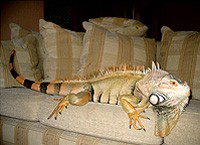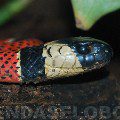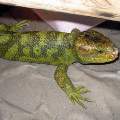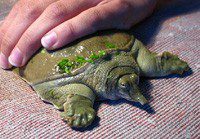
Trionics Chinese
When it comes to a turtle, many people tend to imagine a reptile, dressed in a hard shell. But of any rule, as you know, there are exceptions. It is precisely such an exception that can be considered Chinese Trionix – the only soft-bodied turtle that lives on the territory of Russia. Her shell does not have hard horny plates, but consists of soft skin. But, despite this, the jaws of Trionix are very strong and equipped with sharp cutting edges. Trionics Chinese differs from the representatives of the order not only in the structural features of the body. This animal is characterized by an amazing reaction speed, which is absent in other turtles. So it is not so easy to catch a Chinese Trionix in the wild. It moves quickly both in water and on land. And the behavior during the hunt Trionics resembles a caiman turtle. He also hides in the mud, setting up an invisible ambush for passing fish or other small aquatic animals. It is almost impossible to accustom Chinese Trionix to life in captivity, to subordinate it to a person and tame it. This reptile is extremely aggressive, which, in combination with sharp jaws, can be dangerous. But if you raise a soft-bodied turtle in captivity from an early age or even from birth, then it can eventually get used to you and even take food from your hands. Well, in the wild, Chinese trionics is a real disaster for fishermen, because he loves to carry fish caught in spread nets. In eastern countries, China and Japan, this turtle is considered a valuable prey for the table, its meat is a special delicacy. Turtle traders place the captured Chinese Trionics in special pools and then sell them at a high price.
Other names
Testudo rostrata – derived from lat. testudo (genus of land turtles) and lat. rostrata (hooked), a feature possibly indicating a long proboscis located on the muzzle of Trionyx.
Trionyx sinensis – lat. trionyx chinensis.
Trionyx stellatus var. japon(ica) – lat. star trionyx.
Trionyx tuberculatus – lat. trionyx is steaming.
Trionyx maackii – Trionyx Maack.
Trionyx schlegeli – Trionyx Schlegel.
Pelodiscus sinensis – from lat. pelodiscus (a genus of Far Eastern tortoises).
Cuora flavomarginata sinensis – from lat. cuora (genus of hinged turtles), lat. flavomarginata (box turtle).
Amyda sinensis – cartilaginous trionyx.
Chinese Softshell Turtle Chinese Trionics.
Far Eastern tortoise, soft-bodied tortoise, Chinese soft-bodied tortoise.
Classification
Kingdom: Animals
Type: Chord
Subtype: Vertebrates
Class: Reptiles
Order: Turtles
Suborder: Hidden-necked turtles
Family: Three-clawed turtles
Genus: Far Eastern turtles
Species: Chinese Trionics
Inhabitation
 Perhaps it can be considered a rule that the name of a species reflects its habitat. In this case, Chinese Trionics is no exception. This amazing reptile lives in Asia, in countries such as China, Vietnam, Korea and on the islands of Hainan and Taiwan. But to see the Chinese Trionyx, it is not at all necessary to cross the eastern borders of Russia. It can also be found in the south of the Far East, for example, in the Amur River basin, along its entire length to the very west of Primorye, as well as in the Ussuri basin and the largest tributaries of this river. The Chinese trionics also settles in closed water bodies, for example, in Lake Khanka. Conventionally, on the territory of Russia, the habitat of this turtle can be divided into two main regions – the Amur region (this includes the area around Lake Gassi in the Khabarovsk Territory) and the Khanka region (meaning the already mentioned Lake Khanka).
Perhaps it can be considered a rule that the name of a species reflects its habitat. In this case, Chinese Trionics is no exception. This amazing reptile lives in Asia, in countries such as China, Vietnam, Korea and on the islands of Hainan and Taiwan. But to see the Chinese Trionyx, it is not at all necessary to cross the eastern borders of Russia. It can also be found in the south of the Far East, for example, in the Amur River basin, along its entire length to the very west of Primorye, as well as in the Ussuri basin and the largest tributaries of this river. The Chinese trionics also settles in closed water bodies, for example, in Lake Khanka. Conventionally, on the territory of Russia, the habitat of this turtle can be divided into two main regions – the Amur region (this includes the area around Lake Gassi in the Khabarovsk Territory) and the Khanka region (meaning the already mentioned Lake Khanka).
These habitats for the Chinese Trionix are, in fact, native. But there are also territories where he was brought. This is, for example, southern Japan, including the Ryukyu archipelago and the Ogasawara Islands. As well as the states of Southeast Asia, such as Thailand, Singapore, Malaysia. In the same way, the Chinese trionics reached the island of Timor in the southern part of the Malay Archipelago, and to Hawaii, and to the group of the Mariana Islands in the western Pacific Ocean in Micronesia. Finally, the soft-bodied tortoise was found in the Chui valley of Kyrgyzstan, where it probably also ended up as an introduced species.
Judging by the habitat, the Chinese Trionix does not have any special climatic preferences, since it feels equally good in the taiga zones, and in subtropical and tropical forests. The main thing is that there should be any fresh body of water with warm water, a muddy or sandy bottom and a gentle slope nearby. True, Trionics is unlikely to be found in rivers with a strong current, but various quiet lakes, old channels and even rice fields flooded with water are quite to his liking. Does not avoid Chinese trionyx and hills. It even tends to climb mountains up to 1700 m above sea level.
Description
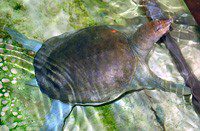 Despite some originality, the Chinese trionyx still looks like an ordinary turtle. He also has a shell, though consisting of skin, elongated and flattened. Its surface is covered with longitudinal tubercles. By the type of shell, you can determine the approximate age of the Chinese trionyx. In young turtles, the tubercles are more noticeable, and as they grow older, they gradually merge into rollers and, finally, disappear completely. Young Chinese Trionics are distinguished from adults by the shape of the shell – more round and relatively high. With age, the shell gradually flattens and acquires an ovoid, expanded downwards shape. The color of the Chinese trionics is sustained in greenish-brown and yellow tones. It is darker above with small yellow spots, and light yellow below, and, again, as it matures, the skin on the carapace turns yellow. The approximate dimensions of the Chinese trionics are 25 – 30 cm. Its weight rarely exceeds 4 kg. It was not by chance that nature created this turtle soft-bodied. With the help of the soft edges of her shell, she manages to better burrow into the silt. The body parts of the Chinese trionix protruding from under the shell also have a greenish-brown color with small spots. A narrow dark stripe runs from the eyes to the temples. The turtle’s head seems to be a continuation of its neck; it is also narrow and elongated, ending in a long soft proboscis with nostrils. This proboscis can extend so far that it easily reaches the tail. And it also allows the Chinese Trionics to stay in the water for a long time. The turtle puts it out of the water and so is saturated with oxygen. However, this is not the only respiratory organ of Chinese Trionics. On the mucous membrane of the pharynx, they have bundles of special villi, which have assumed the role of gills. And another rare feature for reptiles, which is endowed with trionics – skin respiration due to the skin richly supplied with blood vessels. All these qualities allow the turtle to stay under water for up to 15 hours. Each paw of the Chinese Trionix has 5 fingers, and 3 of them end in sharp claws. Swimming membranes between the fingers provide quick movement in the water for Trionics. But the jaws of the soft-bodied trionix are surprisingly sharp, however, their horny edges are, as it were, covered with leather rollers resembling lips. The Chinese Trionics prefers to hunt in the water and bask on the shore. The turtle is strongly attached to its reservoir, it rarely leaves it even when shallow or polluted. Trionyx spends most of its time burrowing into the silt, from where it attacks its prey, mainly at night. In the same place, the animal hibernates from the beginning of autumn to late spring or the first summer days.
Despite some originality, the Chinese trionyx still looks like an ordinary turtle. He also has a shell, though consisting of skin, elongated and flattened. Its surface is covered with longitudinal tubercles. By the type of shell, you can determine the approximate age of the Chinese trionyx. In young turtles, the tubercles are more noticeable, and as they grow older, they gradually merge into rollers and, finally, disappear completely. Young Chinese Trionics are distinguished from adults by the shape of the shell – more round and relatively high. With age, the shell gradually flattens and acquires an ovoid, expanded downwards shape. The color of the Chinese trionics is sustained in greenish-brown and yellow tones. It is darker above with small yellow spots, and light yellow below, and, again, as it matures, the skin on the carapace turns yellow. The approximate dimensions of the Chinese trionics are 25 – 30 cm. Its weight rarely exceeds 4 kg. It was not by chance that nature created this turtle soft-bodied. With the help of the soft edges of her shell, she manages to better burrow into the silt. The body parts of the Chinese trionix protruding from under the shell also have a greenish-brown color with small spots. A narrow dark stripe runs from the eyes to the temples. The turtle’s head seems to be a continuation of its neck; it is also narrow and elongated, ending in a long soft proboscis with nostrils. This proboscis can extend so far that it easily reaches the tail. And it also allows the Chinese Trionics to stay in the water for a long time. The turtle puts it out of the water and so is saturated with oxygen. However, this is not the only respiratory organ of Chinese Trionics. On the mucous membrane of the pharynx, they have bundles of special villi, which have assumed the role of gills. And another rare feature for reptiles, which is endowed with trionics – skin respiration due to the skin richly supplied with blood vessels. All these qualities allow the turtle to stay under water for up to 15 hours. Each paw of the Chinese Trionix has 5 fingers, and 3 of them end in sharp claws. Swimming membranes between the fingers provide quick movement in the water for Trionics. But the jaws of the soft-bodied trionix are surprisingly sharp, however, their horny edges are, as it were, covered with leather rollers resembling lips. The Chinese Trionics prefers to hunt in the water and bask on the shore. The turtle is strongly attached to its reservoir, it rarely leaves it even when shallow or polluted. Trionyx spends most of its time burrowing into the silt, from where it attacks its prey, mainly at night. In the same place, the animal hibernates from the beginning of autumn to late spring or the first summer days.
Food
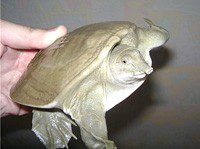 In general, all turtles can be divided into two groups according to the type of food – herbivores, who prefer mostly plant foods, and predators. The Chinese trionics just belongs to the second. Moreover, he is quite a dangerous predator. More than one catcher happened to suffer from his sharp jaws. The Chinese Trionyx hunts fish passing by in the water. He also eats various amphibians, mollusks, crustaceans, worms and small insects. At night, Trionics can explore the bottom of the reservoir in search of prey. The fish caught by the turtle is quite large. First, the Chinese Trionics bites off her head. This reptile is surprisingly gluttonous. Scientists observing the life of Trionix in captivity noticed that at one time he can eat three, four small fish.
In general, all turtles can be divided into two groups according to the type of food – herbivores, who prefer mostly plant foods, and predators. The Chinese trionics just belongs to the second. Moreover, he is quite a dangerous predator. More than one catcher happened to suffer from his sharp jaws. The Chinese Trionyx hunts fish passing by in the water. He also eats various amphibians, mollusks, crustaceans, worms and small insects. At night, Trionics can explore the bottom of the reservoir in search of prey. The fish caught by the turtle is quite large. First, the Chinese Trionics bites off her head. This reptile is surprisingly gluttonous. Scientists observing the life of Trionix in captivity noticed that at one time he can eat three, four small fish.
When keeping these turtles in a home terrarium, they should create a combined diet, which, in addition to fish, may include meat, such as pork or beef, some vegetables such as lettuce or cabbage, as well as amphibian larvae, tadpoles, bloodworms and artificial food from pet stores. Zoologists recommend adding special vitamin and mineral supplements to Chinese trionix food. In this case, the turtle has a chance to live next to you for up to 25 years.
Reproduction
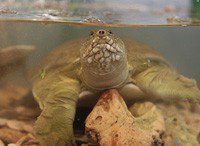 Unlike many other species of turtles, the Chinese Trionyx breeds well in captivity, provided that the necessary requirements for its maintenance are met. Since in nature the mating of turtles occurs immediately after wintering, the imitation of the winter climate helps to stimulate the reproduction of the Chinese trionyx. To do this, the turtle should create a certain water temperature – + 15- + 18 degrees for 1 – 5 months. But you should not immediately place Trionix in conditions that mimic cold. It is better to gradually lower the water temperature and reduce the duration of daylight hours.
Unlike many other species of turtles, the Chinese Trionyx breeds well in captivity, provided that the necessary requirements for its maintenance are met. Since in nature the mating of turtles occurs immediately after wintering, the imitation of the winter climate helps to stimulate the reproduction of the Chinese trionyx. To do this, the turtle should create a certain water temperature – + 15- + 18 degrees for 1 – 5 months. But you should not immediately place Trionix in conditions that mimic cold. It is better to gradually lower the water temperature and reduce the duration of daylight hours.
Sexual maturity in Chinese trionics occurs at 6-7 years of age. In nature, a fertilized female makes clutches about 3 times per season – from May to August. For the nest, she chooses well-warmed places on the shore. The nest of the Chinese trionix is a rounded hole dug by the female about 20 cm deep. The number of eggs in one clutch is about 20-70 pieces. The waiting time for offspring is 1-5 months. The small Chinese trionics that were born are distinguished by a bright orange color of the abdomen.
In captivity, turtles also mate in the water. And if fertilization was successful, then the owners need to provide the female with a place for a nest. For this, a deep container with a soft filler, such as sand mixed with earth or coconut substrate, is suitable. However, in captivity, the Chinese Trionix masonry is not allowed to “ripen” on its own, and some time after the eggs are laid, they are placed in an incubator with a suitable temperature of + 27- + 30 degrees.
Under artificial conditions, the female of the Chinese Trionix lays eggs in the same way as in nature – three times with a break of 5-6 days. How many eggs can be laid depends on the age of the turtle. In adult females, clutches are more numerous. The eggs of the Chinese Trionix are quite large, beige or yellowish, about 10 cm in diameter. In a small clutch, the eggs are always larger. The newborn trionics that emerged from them usually do not exceed 3 cm in size.
In some habitats, where the number of soft-bodied turtles is high, they make massive clutches. And since Chinese trionyx eggs are also valued as tasty food, collectors find these clutches in small holes left after burying the nest. Near the nest, it is often possible to find a nesting path trodden by the female.
Content
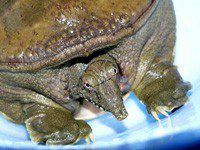 Chinese Trionics as a pet is especially appreciated by exotic lovers. They supply this turtle for sale from Asia and transport it always in the water. And since the reptile is quite active and mobile, the conditions for its maintenance must be carefully prepared. The best home for the Chinese Trionics can be a spacious aquaterrarium with a volume of 250 liters per adult turtle. But, of course, there should be a place for arranging land, which should occupy about a fifth of its area. A suitable water temperature of +26 degrees should be maintained with a special heater. It is also necessary to install a special filter in the terrarium, as well as a device that supplies oxygen to the water so that the Chinese Trionics can receive it to the fullest. To prevent the turtle from getting sick, you should defend the water when filling the aquarium or reduce the chlorine content in it with the help of special preparations. An incandescent lamp and an ultraviolet lamp are also needed. If the Chinese Trionics has been raised in captivity since birth, then there is a chance to tame this aggressive predator.
Chinese Trionics as a pet is especially appreciated by exotic lovers. They supply this turtle for sale from Asia and transport it always in the water. And since the reptile is quite active and mobile, the conditions for its maintenance must be carefully prepared. The best home for the Chinese Trionics can be a spacious aquaterrarium with a volume of 250 liters per adult turtle. But, of course, there should be a place for arranging land, which should occupy about a fifth of its area. A suitable water temperature of +26 degrees should be maintained with a special heater. It is also necessary to install a special filter in the terrarium, as well as a device that supplies oxygen to the water so that the Chinese Trionics can receive it to the fullest. To prevent the turtle from getting sick, you should defend the water when filling the aquarium or reduce the chlorine content in it with the help of special preparations. An incandescent lamp and an ultraviolet lamp are also needed. If the Chinese Trionics has been raised in captivity since birth, then there is a chance to tame this aggressive predator.
Sources of
http://ru.wikipedia.org/
http://www.cherepahi.ru/
http://www.floranimal.ru/
http://www.veterinar-info.ru
http://www.sevin.ru/
http://www.zoopodolsk.ru/



